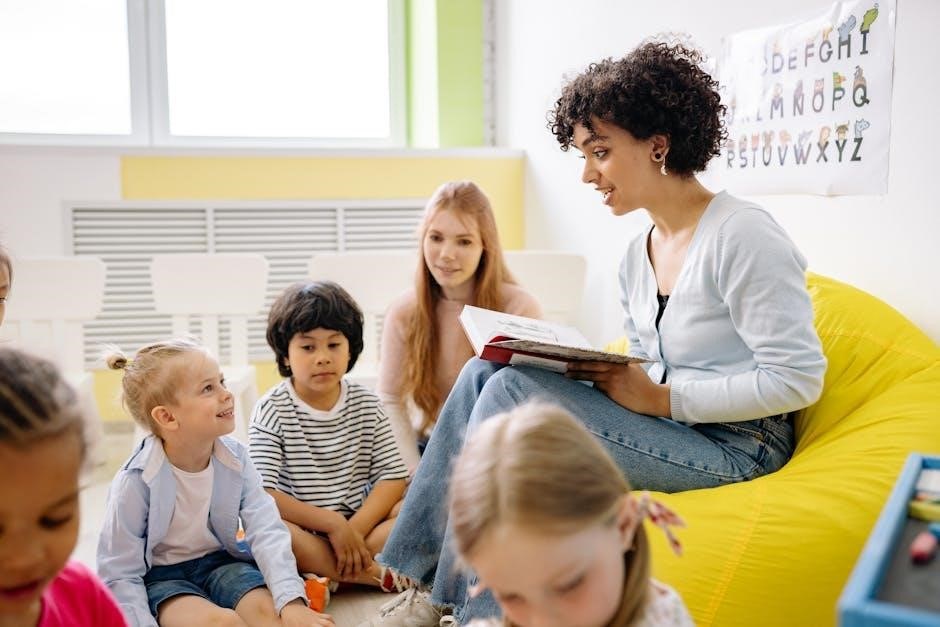Guided reading lesson plans provide a structured approach to teaching reading, emphasizing small-group instruction and differentiated strategies to meet diverse student needs, fostering literacy growth effectively.
1.1 Definition and Purpose of Guided Reading
Guided reading is an instructional approach where teachers work with small groups of students to support reading development. It involves direct teaching, observation, and feedback, tailored to the group’s needs. The purpose is to promote reading accuracy, fluency, and comprehension while fostering a deeper understanding of texts. This method bridges the gap between instruction and independent reading, helping students build confidence and skills in a supportive environment.
1.2 Importance of Guided Reading in Education
Guided reading is essential in education as it provides personalized instruction, allowing teachers to address diverse learning needs. It enhances reading proficiency by fostering fluency, comprehension, and critical thinking. This approach supports students in developing a deeper understanding of texts and prepares them for independent reading. By offering targeted feedback and scaffolding, guided reading helps build confidence and literacy skills, ensuring all learners progress effectively.

Key Components of a Guided Reading Lesson Plan
A guided reading lesson plan includes pre-reading activities, during reading strategies, and post-reading discussions. These components ensure a structured and engaging approach to fostering literacy growth effectively.
2.1 Pre-Reading Activities
Pre-reading activities are essential to engage students and build foundational understanding. These include activating prior knowledge, setting reading purposes, introducing vocabulary, and previewing the text. Teachers use discussions, visuals, or K-W-L charts to connect students’ experiences with the material, fostering curiosity and readiness for the reading task. Such activities ensure students approach the text with focus and relevant background knowledge, enhancing comprehension and participation during guided reading sessions.
2.2 During Reading Strategies
During reading, teachers employ strategies to support comprehension and engagement. Close reading, think-alouds, and guided questioning encourage active participation. Teachers may pause to clarify complex texts, model fluency, or highlight key vocabulary. Digital tools, such as interactive annotations, can also enhance understanding. These strategies help students connect with the text, monitor their comprehension, and develop critical thinking skills, ensuring a productive and meaningful reading experience tailored to their learning needs.
2.3 Post-Reading Discussions and Reflections
Post-reading discussions and reflections are crucial for reinforcing comprehension and critical thinking. Teachers facilitate open-ended questions, encouraging students to share insights and connect the text to prior knowledge. Strategies like think-pair-share or written reflections help students articulate their understanding. These activities also allow educators to assess learning and provide feedback, fostering a deeper engagement with the material and promoting lifelong reading habits.

Structuring a Guided Reading Lesson Plan
Structuring a guided reading lesson plan involves aligning activities with learning goals, managing time effectively, and ensuring a logical flow to maximize student engagement and understanding.
3.1 Aligning with Grade-Level Standards
Aligning guided reading lesson plans with grade-level standards ensures that instruction meets educational benchmarks. Educators can achieve this by consulting curriculum documents and incorporating strategies that address specific skills. This alignment guarantees that students progress toward expected learning outcomes, making instruction coherent and purposeful. Additionally, aligning lessons with standards facilitates accurate assessments, ensuring that teaching methods and materials support the mastery of essential reading competencies outlined in educational frameworks. This approach fosters accountability and ensures that all students receive targeted support to meet grade-level expectations, promoting equitable learning opportunities and continuous academic growth. By integrating standards into guided reading, educators create a structured yet flexible learning environment that caters to diverse needs while maintaining academic rigor. This practice not only enhances student performance but also aligns with broader educational goals, ensuring that guided reading lessons are both effective and relevant. Moreover, aligning with standards allows educators to track progress systematically, identifying areas where additional support or enrichment may be necessary. This data-driven approach enables teachers to refine their instruction, ensuring that all students have the opportunity to succeed and grow as readers. Ultimately, aligning guided reading with grade-level standards is a cornerstone of effective literacy instruction, providing a clear roadmap for teaching and learning while fostering a love for reading in students. Educators must stay informed about evolving standards and adapt their lesson plans accordingly to maintain relevance and effectiveness in their instructional practices.
3.2 Time Management and Pacing
Effective time management and pacing are crucial for guided reading lessons, ensuring that each session is productive and engaging. Teachers should allocate specific time blocks for pre-reading, reading, and post-reading activities to maintain focus. Pacing should be adjusted based on student needs and text complexity, allowing for deeper comprehension without rushing. Clear timelines help keep lessons structured, maximizing learning outcomes and fostering a rhythm that supports student engagement and understanding. Proper pacing ensures that all components of the lesson are covered efficiently, promoting academic success and a positive reading environment.

Differentiation in Guided Reading
Guided reading promotes differentiation by tailoring instruction to diverse student needs, using flexible grouping, scaffolding, and varied texts to support individual learning and comprehension growth effectively.
4.1 Strategies for Diverse Learners
Guided reading supports diverse learners by using flexible grouping, scaffolding techniques, and differentiated texts. Teachers can incorporate visual, auditory, and kinesthetic approaches to engage students with varying learning styles and abilities. Strategies like leveled readers, graphic organizers, and think-aloud protocols help cater to individual needs, ensuring all students can access and comprehend the material effectively. This approach fosters inclusivity and promotes equitable learning opportunities.
4.2 Incorporating Visual, Auditory, and Kinesthetic Approaches
Guided reading can be enhanced by integrating visual, auditory, and kinesthetic methods. Visual tools like graphic organizers and diagrams help students process information. Auditory approaches, such as audio books or read-alouds, engage listeners and model fluency; Kinesthetic activities, like acting out stories or using manipulatives, cater to tactile learners. These multisensory strategies create a dynamic learning environment, ensuring all students can engage with the material in ways that align with their individual learning preferences and strengths.
Assessing Student Progress
Assessments track students’ reading growth, identifying strengths and areas needing support, ensuring instruction is tailored to their evolving needs for improved learning outcomes.
5.1 Formative and Summative Assessments
Formative assessments monitor progress during guided reading, using observations, quizzes, and discussions to adjust instruction. Summative assessments evaluate learning at the end of a lesson or unit, often through tests or projects. Both types provide valuable data to inform teaching strategies, ensuring students meet grade-level standards and achieve long-term reading goals effectively.
5.2 Using Data to Inform Instruction
Using data to inform instruction involves analyzing assessment results to tailor teaching strategies. Educators can identify learning gaps, track progress, and adjust lesson plans accordingly. Tools like Google Sheets Query function enable efficient data analysis, while prompting techniques help refine instructional approaches. By leveraging insights from formative and summative assessments, teachers can create targeted interventions, ensuring personalized learning experiences that address individual student needs effectively and enhance overall academic outcomes.
Integrating Technology in Guided Reading
Integrating technology enhances guided reading by providing interactive tools, digital texts, and multimedia resources, making learning engaging and accessible for students with diverse learning styles and needs.
6.1 Digital Tools for Interactive Reading
Digital tools like Google Docs, Padlet, and Kahoot enhance interactive reading by allowing students to collaborate, highlight text, and engage in real-time discussions. These platforms provide immediate feedback and foster a dynamic learning environment, making guided reading sessions more engaging and effective for students with diverse learning styles.
6.2 Audio and Visual Resources to Enhance Comprehension
Audio and visual resources, such as audiobooks, videos, and interactive graphics, enrich guided reading by providing multisensory learning experiences. These tools help students visualize stories, improve listening skills, and deepen understanding of complex texts. Visual aids like diagrams and timelines also support comprehension, while audio resources cater to auditory learners, ensuring inclusive and engaging lessons for all students.

Cultural and Linguistic Considerations
Culturally responsive teaching involves selecting diverse texts that reflect students’ backgrounds, fostering inclusivity and connection. Linguistic supports, like scaffolding language instruction, ensure all learners, including multilingual students, can engage meaningfully.
7.1 Selecting Diverse and Inclusive Texts
Selecting diverse and inclusive texts is crucial for fostering empathy and representation in guided reading. Texts should reflect students’ backgrounds, cultures, and experiences, ensuring all learners feel valued. Incorporate literature that highlights diverse voices, perspectives, and histories to promote inclusivity. Use genres and topics that resonate with students’ lives, making reading relatable and engaging. This approach supports cultural responsiveness and encourages students to connect deeply with the material, fostering a sense of belonging and understanding.
7.2 Supporting English Language Learners
Supporting English language learners in guided reading involves using visual aids, simplified language, and scaffolding techniques. Incorporate bilingual texts or translation tools to enhance comprehension. Provide additional time for processing and encourage peer support. Use audio resources to model fluent reading and pronunciation. Differentiate instruction to meet varying language proficiency levels, ensuring all learners can engage meaningfully with the text. These strategies foster language development and confidence, making reading accessible and effective for ELLs.
Parental and Community Involvement
Parental and community involvement enhances guided reading by fostering collaboration and literacy growth. Engage families through communication and encourage home reading practices to support student success collectively.
8.1 Communicating with Parents
Effective communication with parents is vital for student success. Teachers can share updates through newsletters, parent-teacher meetings, and digital platforms. Regularly providing insights into guided reading activities ensures parents understand their child’s progress. Encouraging open dialogue helps address concerns and fosters a collaborative learning environment. By maintaining consistent communication, educators empower parents to support literacy development at home, creating a stronger partnership between school and family.
8.2 Encouraging Home Reading Practices
Encouraging home reading practices strengthens literacy skills and reinforces classroom instruction. Teachers can provide parents with strategies, such as setting aside dedicated reading time, discussing texts, and creating a cozy reading environment. Offering book recommendations and tips for engaging discussions helps parents support their child’s reading growth. Consistent home practices, combined with school efforts, foster a love for reading and improve overall literacy development in students.

Managing Challenges in Guided Reading
Guided reading can present challenges like managing group dynamics and keeping students engaged. Effective strategies are essential to address these issues and ensure productive learning experiences.
9.1 Addressing Behavior and Engagement Issues
Addressing behavior and engagement issues in guided reading requires proactive strategies. Positive reinforcement, clear expectations, and visual reminders can help manage disruptions. Incorporating interactive activities and technology enhances engagement, while differentiated instruction ensures all students stay focused. Encouraging participation through group discussions and hands-on tasks fosters a supportive environment. Monitoring progress and adjusting strategies as needed helps maintain productive learning experiences for all students.
9.2 Strategies for Reluctant Readers
Strategies for reluctant readers include personalized texts, positive reinforcement, and confidence-building activities. Encourage their interests with relevant materials, and provide a supportive environment for exploration. Differentiated instruction and interactive tools can make reading engaging. Peer reading or buddy systems foster collaboration. Celebrate small achievements to build motivation and gradually increase reading confidence. These approaches help reluctant readers develop a positive relationship with reading.

Best Practices for Guided Reading
Best practices include creating a supportive environment, encouraging active participation, differentiated instruction, constructive feedback, and making reading enjoyable for all students.
10.1 Creating a Supportive Reading Environment
Creating a supportive reading environment involves organizing a quiet, well-lit space with comfortable seating and necessary resources. Ensure the atmosphere is safe, respectful, and inclusive for all learners. Use flexible seating arrangements and provide access to diverse texts that reflect students’ backgrounds and interests. Incorporate visual aids like word walls or reading charts to enhance engagement. Encourage peer discussions and critical thinking, fostering a love for reading and a growth mindset through positive reinforcement and constructive feedback.
10.2 Encouraging Critical Thinking and Deep Discussion
Encouraging critical thinking and deep discussion in guided reading involves using open-ended questions, think-pair-share activities, and Socratic seminars. These strategies prompt students to analyze texts, explore multiple perspectives, and articulate their thoughts clearly. Incorporating visual aids and reflective practices further enhances comprehension and engagement, fostering a deeper understanding of the material and promoting meaningful conversations that extend beyond surface-level interpretations.
Guided reading lesson plans effectively foster literacy skills, critical thinking, and a love for reading, ensuring continuous improvement in teaching practices for diverse learners.
11.1 Summarizing Key Takeaways
Guided reading lesson plans are essential for fostering literacy skills, promoting comprehension, and encouraging critical thinking. By incorporating differentiation, technology, and cultural considerations, educators create supportive environments that cater to diverse learners. Regular assessments and data-driven instruction ensure progress tracking and tailored strategies. Engaging students through pre-, during, and post-reading activities enhances their reading experiences. Ultimately, guided reading nurtures a lifelong love for reading while equipping students with essential skills for academic success and beyond.
11;2 Continuous Improvement in Guided Reading Practices
Continuous improvement in guided reading involves ongoing professional development, refining teaching methods, and adapting strategies based on student needs and feedback. Educators should regularly assess their approaches, incorporating new research and best practices to enhance instruction. Leveraging technology, seeking peer collaboration, and staying informed about literacy trends ensure that guided reading remains dynamic and effective. This commitment to growth fosters a supportive and adaptive learning environment for all students.
